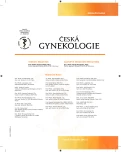Selective progesterone receptor modulators and their therapeutical use
Authors:
Daniel Driák 1
; B. Sehnal 1; I. Švandová 2
Authors‘ workplace:
Gynekologicko-porodnická klinika 1. LF UK a Nemocnice Na Bulovce, Praha, přednosta prof. MUDr. M. Halaška, DrSc.
1; Oddělení neurobiologie, Katedra fyziologie, Přírodovědecká fakulta UK, Praha
2
Published in:
Ceska Gynekol 2013; 78(2): 175-181
Overview
Currently developed selective progesterone receptor modulators (SPRMs) are steroid derived compounds with a bulky radical substitution at carbon 11. They interact with progesterone receptor and exert antagonistic or/and agonistic effects. Mifepristone was approved for pregnancy termination and ulipristal acetate as emergency contraception and pharmacological therapy of uterine fibroids. SPRMs inhibit endometrial proliferation and myoma growth, this suggests a therapeutical effect in cases of endometriosis and other estrogen-dependent diseases.
Keywords:
progesterone – progesterone receptor –selective progesterone receptor modulators – agonists and antagonists of progesterone – pregnancy termination – emergency contraception
Sources
1. Aubény, E. Medical abortion at home. Eur J Contracept Reprod Health Care, 2008, 13, suppl 2, p. 189–190.
2. Bouchard, P., Chabbert-Buffet, N., Fauser, BCJM. Selective progesterone receptor modulators in reproductive medicine: pharmacology, clinical efficacy and safety. Fertil Steril, 2011, 96, 5, p. 1175–1189.
3. Brache, V., Cochon, L., Jesam, C., et al. Immediate pre-ovulatory administration of 30 mg ulipristal acetate significantly delays follicular rupture. Hum Reprod, 2010, 25, 9, p. 2256–2263.
4. Ganong, WF. Přehled lékařské fyziologie. 20. ed. Praha: Galén, 2005, 890 s.
5. Gemzell-Danielsson, K., Marions, L. Mechanisms of action of mifepristone and levonorgestrel when used for emergency contraception. Hum Reprod Update, 2004, 10, 4, p. 341–348.
6. Glasier, AF., Cameron, ST., Fine, PM., et al. Ulipristal acetate versus levonorgestrel for emergency contraception: a randomised non-inferiority trial and meta-analysis. Lancet, 2010, 375, 9714, p. 555–562.
7. Chabbert-Buffet, N. Selective progesterone receptor modulators. Eur J Contracept Reprod Health Care, 2010, 15, suppl 1, p. 7–8.
8. Chabbert-Buffet, N., Ouzounian, S., Kairis, AP., Bouchard, P. Contraceptive applications of progesterone receptor modulators. Eur J Contracept Reprod Health Care, 2008, 13, 3, p. 222–230.
9. Kreutner, AK. Infekční komplikace po interrupci. Komentář: Charvát, M. Gynek po prom, 2001, 1, 6, s. 72–75.
10. Mani, SK., Mermelstein, PG., Tetel MJ., Anesetti G. Convergence of multiple mechanisms of steroid hormone action. Horm Metab Res, 2012, 44, 8, p. 569–576.
11. Marions, L., Hultenby, K., Lindell, I., et al. Emergency contraception with mifepristone and levonorgestrel: mechanism of action. Obstet Gynecol, 2002, 100, 1, p. 65–71.
12. McKeage, K., Croxtall, JD. Ulipristal acetate: a review of its use in emergency contraception. Drugs, 2011, 71, 7, p. 935–945.
13. Scott, LJ., McKeage, K., Croxtall, JD. Ulipristal acetate: a guide to its use in emergency contraception. Drugs Ther Perspect, 2012, 28, 2, p. 6–9.
14. Tsereteli, T., Chong, E., Tsertsvadze, G., et al. A comparison of two dosages of buccal Misoprostol following Mifepristone for early medical abortion. Eur J Contracept Reprod Health Care, 2008, 13, suppl 2, p. 43–44.
15. Winikoff, B., Creinin, M., Crowden, W., et al. Expanding options for in-the-mouth Misoprostol administration following Mifepristone in medical abortion. Eur J Contracept Reprod Health Care, 2008, 13, suppl 2, p. 44.
Labels
Paediatric gynaecology Gynaecology and obstetrics Reproduction medicineArticle was published in
Czech Gynaecology

2013 Issue 2
Most read in this issue
- Transfusion-related acute lung injury (TRALI) – review
- Reccurent pregnancy loss – review
- Evaluation of p16 protein in the managementof cervical dysplasia
- Hyperlipidaemia in pregnancy
